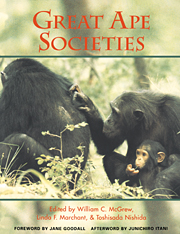Book contents
- Frontmatter
- Contents
- List of contributors
- Preface
- Foreword: conserving great apes
- Part I Apes overviewed
- Part II Social ecology
- Part III Social relations
- Part IV Minds
- Part V Apes compared
- Part VI Modeling ourselves
- 20 Savanna chimpanzees, referential models and the last common ancestor
- 21 Reconstructions reconsidered: chimpanzee models and human evolution
- Afterword: a new milestone in great ape research
- Appendix: great ape study sites
- Index
20 - Savanna chimpanzees, referential models and the last common ancestor
Published online by Cambridge University Press: 04 August 2010
- Frontmatter
- Contents
- List of contributors
- Preface
- Foreword: conserving great apes
- Part I Apes overviewed
- Part II Social ecology
- Part III Social relations
- Part IV Minds
- Part V Apes compared
- Part VI Modeling ourselves
- 20 Savanna chimpanzees, referential models and the last common ancestor
- 21 Reconstructions reconsidered: chimpanzee models and human evolution
- Afterword: a new milestone in great ape research
- Appendix: great ape study sites
- Index
Summary
INTRODUCTION
Many a great ape grant proposal has waxed on about insights that the proposed research would provide into the behavioral ecology of our early ancestors (see Zihlman, Chapter 21), and the term ‘model’ is ubiquitous in the resulting literature (e.g. Jolly, 1970; Kinzey, 1987). What is a model in this context? It is important to know, because (justified or not) people often draw inferences about modern humans from such models. Skybreak (1984) describes the referential (i.e. analogical with an existing species) baboon model:
Implicitly or explicitly, savanna baboons have been repeatedly proposed as models for our own earliest origins or as a basis for understanding human aggression, xenophobia, class structure, and the domination of women, all seen as rooted in biological evolution (and by implication, thus very resistant to change).
Skybreak, 1984, p. 84One might think that she would reject all such referential models, with their putative biological determinism, but instead she supports Tanner's (1981) chimpanzee model. One of the many meanings of the word ‘model’ is ‘something held up before one for imitation or guidance’ (Webster's New Collegiate Dictionary, 1951), and one wonders whether there might be some cognitive spillover among usages.
- Type
- Chapter
- Information
- Great Ape Societies , pp. 275 - 292Publisher: Cambridge University PressPrint publication year: 1996
- 78
- Cited by



